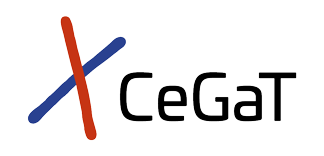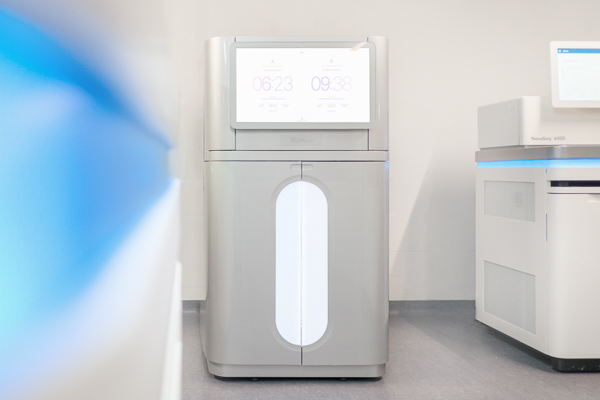Transcriptomic technologies provide crucial insights into cellular characteristics. Changes in a cell’s surroundings can change its transcriptome. As cells cluster together to form tissues, the transcriptome of each individual cell is strongly affected by the surrounding tissue. Thus, bringing a cell’s transcriptome in context with its tissue morphology can give valuable, novel insights. Spatial transcriptome sequencing combines conventional staining and imaging methods with RNA sequencing. With the resulting complex data, biological architectures can be disentangled. Furthermore, spatial transcriptome sequencing can unravel tissue heterogeneity, enable tissue classification based on expression profiles, and lead to the discovery of new biomarkers.
We offer various Spatial Transcriptome Sequencing products to discover novel insights into disease pathology, development, and translational research.
CeGaT Is the Best Partner for Sequencing Your Project
Our Commitment to You
Fast Processing
Turnaround time
≤ 15 business days
High Quality
Highest accuracy for all processes
Secure Delivery
Secure provision of sequenced data via in-house servers
Safe Storage
Safe storage of samples and data after project completion
Our Service
We provide a comprehensive and first-class project support – from selecting the appropriate product to evaluating the data. Each project is supervised by a committed scientist. You will have a contact person throughout the whole project.
Our service includes:
- detailed project consulting
- product selection tailored to your project
- detailed bioinformatic evaluation of your data
- detailed project report with information about sample quality, sequencing parameters, bioinformatic analysis, and results
Benefit from our dedicated support and accredited workflows.
Explore Our Product Portfolio for Spatial Transcriptome Sequencing
We offer different Spatial Transcriptome Sequencing (STS) products to address a variety of research questions. The products differ in their resolution and the sample type. You can choose between our standard (SD) products and the high-definition (HD) products, which are both suitable for FFPE tissue blocks and FFPE sections. If you want to learn more about the resolution differences between our SD and HD products, you might have a look at our information flyer . Each of our products can be supplemented with further services. We are happy to advise you.
STS SD Block | STS SD Slide | STS HD Block | STS HD Slide |
Species | Species | Species | Species |
Sample type | Sample type | Sample type | Sample type |
Target Gene expression + spatial information | Target Gene expression + spatial information | Target Gene expression + spatial information | Target Gene expression + spatial information |
Platform | Platform | Platform | Platform |
Resolution | Resolution | Resolution | Resolution |
Output 125 million read pairs
| Output 125 million read pairs
| Output 275 million read pairs
| Output 275 million read pairs
|
Included deliverables | Included deliverables | Included deliverables | Included deliverables |
Bioinformatics
Raw sequencing data are automatically processed. We analyze your Spatial Transcriptome Sequencing data with the Space Ranger software from 10x Genomics®. This workflow includes demultiplexing of the sequencing data (including index reads, FASTQ format), mapping of the sequencing reads (BAM format), generation of standard Loupe Browser visualization files (CLOUPE format), generation of mapped count tables for downstream analysis (TSV format), preliminary cell clustering analysis (CSV format), and preliminary gene expression analysis (CSV format). Your expression data is combined with the H&E image containing the morphological information. Matrix files (H5 format) contain the compressed results. An interactive web summary contains summary metrics and the secondary analysis results (HTML format). In addition to the data, a project report is generated (PDF format).
Technical Information
For both product types – STS SD and STS HD – two samples of the same product type can be run in parallel on one 10x Genomics® Visium slide, as one slide holds two capture areas. Each capture area has a size of 6.5 mm x 6.5 mm.
For STS SD, the Visium slide contains approximately 5,000 barcoded spots per capture area. It is recommended to sequence at least 25,000 read pairs per tissue-covered spot, resulting in 125 million read pairs per fully covered capture area. If the capture area of 6.5 mm x 6.5 mm is too small for your project, please let us know. Visium slides for STS SD with two capture areas of 11 mm x 11 mm and 14,000 barcoded spots each are also available.
For STS HD, the Visium slide contains approximately 11 million continuous barcoded squares. It is recommended to sequence 275 million read pairs per fully covered capture area.
At CeGaT, sequencing is performed using the Illumina sequencing platforms. If you require another sequencing depth, please let us know! We can provide further solutions.
Further Information about Spatial Transcriptome Sequencing
Single-cell RNA sequencing has considerably promoted biomedical research in the field of transcriptomics. With single-cell RNA sequencing, the heterogeneity within biological samples can be analyzed on a single-cell level. However, due to the use of single-cell suspensions, single-cell RNA sequencing approaches usually destroy the histological organization of the tissue, resulting in the loss of spatial information. In consequence, it remains unclear how cells interact with their microenvironment and how this interaction affects each individual cell within the tissue as well as the tissue as a whole. Spatial transcriptome sequencing, also known as spatial transcriptomics or spatially resolved transcriptomics, combines gene expression with the cell’s localization in a tissue. With spatial transcriptome sequencing, the information about the spatial context of a cell in a certain tissue is preserved. By combining the knowledge of gene expression and its localization within a tissue, we can better understand the organization of cells and tissues in health and disease. Spatial transcriptome sequencing can, for example, be used in basic and clinical research, especially in the fields of neuroscience, cancer biology, or developmental biology.
Spatial transcriptomics provides new insights into the complex diversity of brain cell types and their organization. These advancements enable a more detailed investigation of neurological diseases, including amyotrophic lateral sclerosis and Alzheimer’s disease.
Spatial transcriptome sequencing can also give valuable insights into cancer research by enabling spatial heterogeneity profiling of tumors and in-depth characterizations of the tumor microenvironment. Furthermore, spatial transcriptomics can deepen the understanding of developmental biology and hematopoiesis. Besides creating spatial maps of complex tissues, complex developmental pathways can be reconstructed with spatial transcriptome sequencing, such as tissue regeneration, embryonic development, or stem cell dynamics. In addition, spatial transcriptomics can also be used in combination with drug assays to analyze a tissue’s response toward different treatments, for example, during drug target identification.
Downloads
Contact Us
Do you have a question or are you interested in our service? Feel free to contact us. We will take care of your request as soon as possible.
Start Your Project with Us
We are happy to discuss sequencing options and to find a solution specifically tailored to your clinical study or research project.
When getting in contact, please specify sample information including starting material, number of samples, preferred library preparation option, preferred sequencing depth and required bioinformatic analysis level, if possible.





